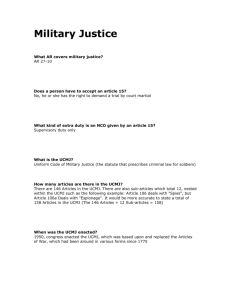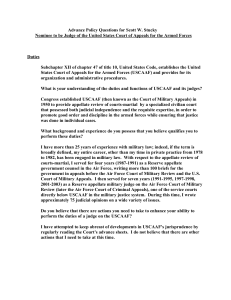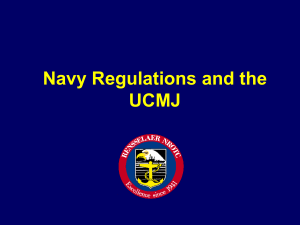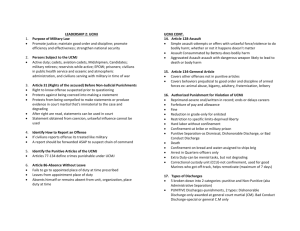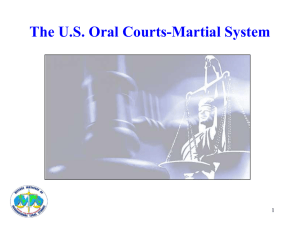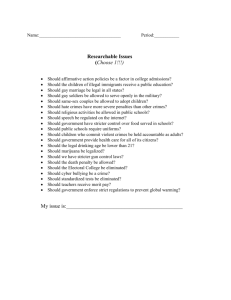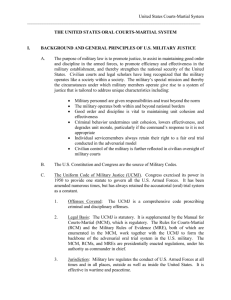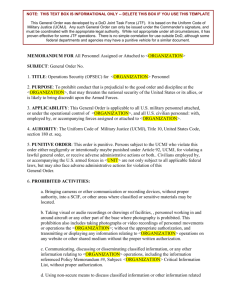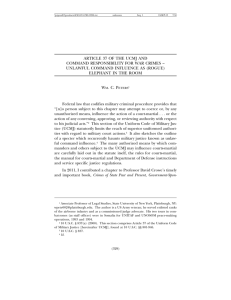Harry & Diane Rinker law library newsletter
advertisement
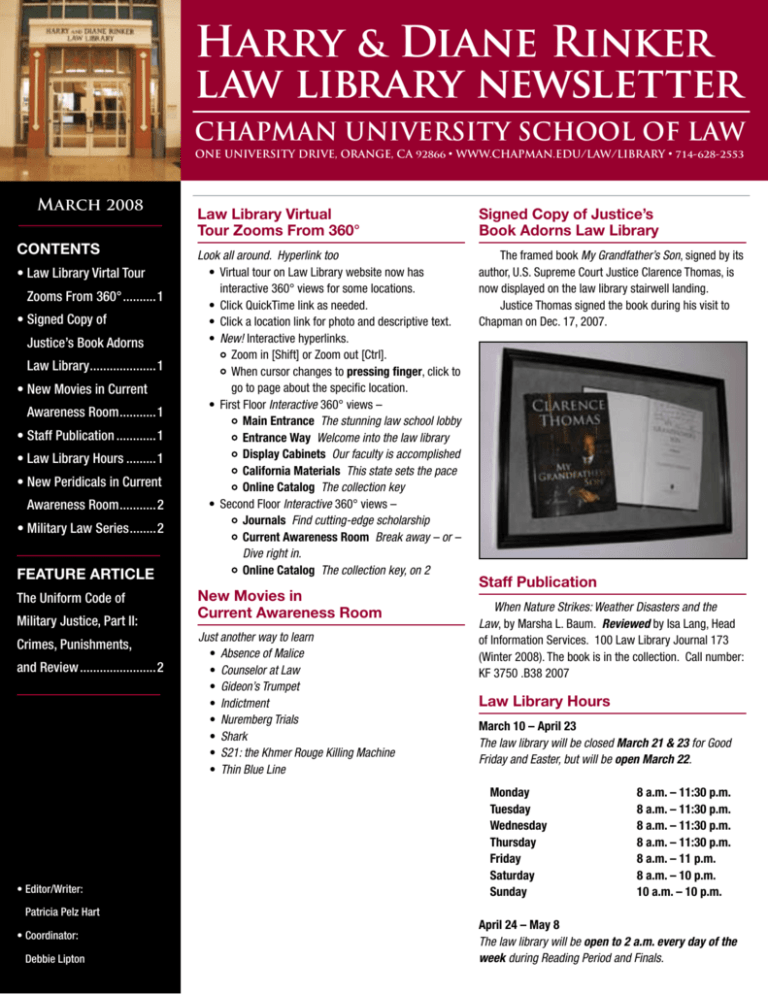
Harry & Diane Rinker law library newsletter CHAPMAN UNIVERSITY SCHOOL OF LAW ONE UNIVERSITY DRIVE, ORANGE, CA 92866 · WWW.CHAPMAN.EDU/LAW/LIBRARY · 714-628-2553 March 2008 CONTENTS • Law Library Virtal Tour Zooms From 360°...........1 • Signed Copy of Justice’s Book Adorns Law Library.....................1 • New Movies in Current Awareness Room............1 • Staff Publication.............1 • Law Library Hours..........1 • New Peridicals in Current Awareness Room............2 • Military Law Series.........2 FEATURE ARTICLE The Uniform Code of Military Justice, Part II: Crimes, Punishments, and Review........................2 • Editor/Writer: Patricia Pelz Hart • Coordinator: Debbie Lipton Law Library Virtual Tour Zooms From 360° Look all around. Hyperlink too • Virtual tour on Law Library website now has interactive 360° views for some locations. • Click QuickTime link as needed. • Click a location link for photo and descriptive text. • New! Interactive hyperlinks. Zoom in [Shift] or Zoom out [Ctrl]. When cursor changes to pressing finger, click to go to page about the specific location. • First Floor Interactive 360° views – Main Entrance The stunning law school lobby Entrance Way Welcome into the law library Display Cabinets Our faculty is accomplished California Materials This state sets the pace Online Catalog The collection key • Second Floor Interactive 360° views – Journals Find cutting-edge scholarship Current Awareness Room Break away – or – Dive right in. Online Catalog The collection key, on 2 New Movies in Current Awareness Room Just another way to learn • Absence of Malice • Counselor at Law • Gideon’s Trumpet • Indictment • Nuremberg Trials • Shark • S21: the Khmer Rouge Killing Machine • Thin Blue Line Signed Copy of Justice’s Book Adorns Law Library The framed book My Grandfather’s Son, signed by its author, U.S. Supreme Court Justice Clarence Thomas, is now displayed on the law library stairwell landing. Justice Thomas signed the book during his visit to Chapman on Dec. 17, 2007. Staff Publication When Nature Strikes: Weather Disasters and the Law, by Marsha L. Baum. Reviewed by Isa Lang, Head of Information Services. 100 Law Library Journal 173 (Winter 2008). The book is in the collection. Call number: KF 3750 .B38 2007 Law Library Hours March 10 – April 23 The law library will be closed March 21 & 23 for Good Friday and Easter, but will be open March 22. Monday Tuesday Wednesday Thursday Friday Saturday Sunday 8 a.m. – 11:30 p.m. 8 a.m. – 11:30 p.m. 8 a.m. – 11:30 p.m. 8 a.m. – 11:30 p.m. 8 a.m. – 11 p.m. 8 a.m. – 10 p.m. 10 a.m. – 10 p.m. April 24 – May 8 The law library will be open to 2 a.m. every day of the week during Reading Period and Finals. New Periodicals in Current Awareness Room In case you thought we were all law, all the time … • Car and Driver • Daily Variety • Esquire • Filmmaker • Foreign Affairs • Good Housekeeping • Harvard Business Review • Hollywood Reporter (Weekly) • Juxtapoz • Mental Health Law Reporter • Mother Jones • National Geographic • The Oprah Magazine • Older Americans Report • Orange Coast Magazine • Psychology Today • PC Magazine • Popular Photography and Imaging • Rolling Stone • Smart Computing • Smithsonian • Sunset • Vanity Fair • Victoria • Village Voice • Wilson Quarterly Military Law Series Research articles on military law on Law Library Web site. Click Library Newsletter and Archive of Past Newsletters. “The JAG Corps: the Military’s Law Office” October 2007 “The UCMJ, Part I: Legislation with Balances” February 2008 “The UCMJ, Part II: Crimes, Punishments, and Review” March 2008 The Uniform Code of Military Justice, Part II: Crimes, Punishments, and Review By Patricia Pelz Hart “The UCMJ, Part I: Legislation with Balances” was in the February 2008 newsletter. The Uniform Code of Military Justice (UCMJ), 10 U.S.C. §§ 801-946, sets forth the criminal law system of the U.S. armed services. The code defines crimes, assigns punishments, establishes courts, lays out pre-trial, trial, and post trial procedures, and designates reviewing bodies. The code is in U.S.C. Title 10, Armed Forces, Subtitle A, General Military Law, Part II, Personnel, Chapter 47, UCMJ. Individual provisions of the UCMJ are generally referred to by Article number, 1-146. To ascertain the Title 10 section, add the number 800 to the Article number. The U.S. Code section number may appear in citations. Part I of this article discussed the legislative history and forces balanced in the UCMJ. This part covers crimes, military trials, and trial review. Subchapter X, Punitive Articles Crimes in the UCMJ may be characterized as decidedly military, typically civilian, or a mixture of both. Subchapter X, Punitive Articles, 10 U.S.C. §§ 877-934 defines the crimes. This is the largest subchapter in the UCMJ, containing Articles 77-134. Actors & Inchoate Offenses The first few punitive articles set forth the MARCH 2008 actors and the stages of action that lead to criminal liability. The UCMJ here resembles civilian criminal codes. An example is the definition of principal in Article 77. A principal is a person who commits or aids, abets, counsels or procures the commission of an offense. The definition is similar to that of California Penal Code § 31. Article 77, however, also includes as principal a person who commands a crime’s commission. The UCMJ’s military subjects and setting are ever present. The definition of accessory after the fact in Article 78 as one who knowingly receives, comforts, or assists an offender, is like that of California Penal Code § 32. The UCMJ crimes of attempts, conspiracy, and solicitation, Articles 80-82, are also similar to civilian versions. Crimes of Discipline Persons who join the armed services hail from all geographic, economic, social, and cultural groups. They must then be welded into an effective military force. Furthermore, the individual services, the army, air force, navy, marines, and coast guard, have separate military purposes, hierarchies, and traditions. Discipline is essential. The UCMJ ensures discipline in ways virtually unique to the military. Fraudulent enlistment, Article 83, is procuring one’s own enlistment by fraud. This is a crime with few if any civilian counterparts. If a person effects an enlistment of someone else known to be ineligible, the first person is guilty of unlawful enlistment under Article 84. It is a crime to willfully disobey a lawful command of a superior commissioned officer, Article 90, or willfully disobey the lawful order of a warrant, noncommissioned, or petty officer, Article 91. Being absent without leave means an unauthorized service member fails to go to, or goes from, his place of duty; or absents himself or remains absent from his unit or required place of duty. Article 86. The acronym is AWOL, which stands for Absent Without Official Leave, or Absent WithOut Leave. Crimes of Warfare Armed forces in any place and at any time would agree that fighting forces are not to engage in behavior that undermines their side or that gives comfort to the enemy. The UCMJ formalizes such proscriptions. Misbehavior before the enemy is forbidden under Article 99. 10 U.S.C. § 899. This is effectively a refusal to fight, by running away, -2- cowardly conduct, or casting down arms or ammunition, and other actions. Actively aiding the enemy, by aiding or attempting to aid the enemy with arms, ammunition, supplies, money, or other things is a crime under Article 104. 10 U.S.C. § 904. A subordinate compelling surrender is one who, without proper authority, compels the commander to give up military property or a body of members to an enemy. Article 100. Service members held captive as prisoners of war (POWs) may have few options for making war. In a prison, however, maintaining discipline become even more important. The UCMJ validates efforts to keep to the code. If a POW tried to curry favor with his jailors to the detriment of other prisoners, he would be guilty of misconduct as prisoner under Article 105. If a person in authority maltreats subordinates without justifiable cause, his conduct would also fall under Article 105. Civilian Type Crimes Human nature being human nature, crimes committed in civilian society may occur within the military as well. The UCMJ therefore contains provisions for crimes that are otherwise removed from the art of warfare. There are crimes of person, for example, murder (Article 118) and manslaughter (Article 119) and crimes of property, such as larceny (Article 121) and arson (Article 126). Conduct Unbecoming The punitive articles subchapter ends with two catchall provisions. Under the first, a commissioned officer may be punished for conduct unbecoming an officer and a gentleman, Article 133. The Article also applies to cadets and midshipmen. The conduct must seriously offend law, justice, morality or decorum, such as by lying, adultery, and fraternization. MARCH 2008 General Article The second catchall provision is the general article, Article 134. This proscribes “all disorders and neglects to the prejudice of good order and discipline in the armed forces, all conduct of a nature to bring discredit upon the armed forces, and crimes and offenses, not capital, of which persons subject to this chapter may be guilty.” Military Court Jurisdiction A military court has jurisdiction when the court is properly convened; the court membership meets requirements; the court has power to try the accused; and the offense is addressed in the UCMJ. A trial in the military is called a court-martial. Personal jurisdiction exists across a spectrum; from members of the armed services to persons accompanying an armed force in time of war. In a few cases, jurisdiction extends to any person. Definitions of offenses begin by stating who is covered for the particular offense. Desertion is a crime for any member of the armed forces. Article 85. Any person subject to this chapter may be court-martialed for making a false official statement. Article 107. Subject to this chapter is defined in Article 2. In addition to service members, among those subject are cadets, aviation cadets, and midshipmen; retired members entitled to pay; prisoners of war in custody; and, in wartime, persons serving with or accompanying an armed force in the field. Any person who aids the enemy may be court-martialed under Article 104. Court-Martial Types Three types of courts-martial exist: general, special, and summary. Article 16. They differ by number of members, jurisdiction, procedures, scale of punishment, rank of offender, and standard times until completion. Court-martials must be called into existence by a court-martial convening authority. For each type of court-martial, the UCMJ designates the persons who may convene it. Articles 22-24. General courts-martial are equivalent to a trial in federal district court. They may try any offense in the UCMJ, but are primarily used for serious offenses. Article 18. A general courtmartial consists of a military judge and no less than five members, if the offense is noncapital. The accused may request a military judge alone. An investigation is required before a charge may be referred to a general court-martial. Article 32. The Article 32 investigation looks at the truth and form of the charges and recommends a disposition. Special courts-martial may try any noncapital and in some cases, capital offense, but the maximum confinement imposed is one year. Article 19. The court-martial may consist of a military judge alone, a military judge and no less than three members, or not less than three members without a military judge. Summary courts-martial are for enlisted personnel only. Article 20. The court-martial is made up of one commissioned officer alone. The officer is judge, trial counsel and defense counsel rolled into one. If the accused objects to a summary court-martial, there may be a trial by general or special court-martial. Summary courts-martial are for relatively minor offenses with a maximum confinement of one month. Court-Martial Members Court-martial members are from the military, a closed world. Hierarchy and deference to authority are stressed from initial training. The members may work in close proximity to each other. Deference, respect, grudges, and other feelings, both positive and negative can unduly influence court deliberations. The UCMJ recognizes these forces and seeks to limit them. Those who may serve on courts-martial are set forth in Article 25. When it can be avoided, no member may be tried by a court-martial member who is junior in rank or grade. This is to avoid payback against higher-ups. Any commissioned officer on active duty is eligible to serve on all courts-martial. Warrant officers may not serve on general and special courts-martial of commissioned officers. In other words, warrant officers may judge only other warrant officers and enlisted personnel. Enlisted personnel get special protection. An enlisted member of the same unit is ineligible to serve. If the enlisted member requests enlisted -3- members on a general or special court-martial, then at least one-third of the members must be enlisted. If that is not possible because of physical conditions or military exigencies, a detailed written statement by the convening authority must be attached to the record. Article 37, unlawfully influencing action of court gives additional insulation against command influence over the court proceedings. Commanding officers and convening authorities may not censure court members with respect to findings or to any exercise of function. No one subject to the chapter may attempt to coerce or inappropriately influence the action. After the trial, Article 37 guards against personal and institutional retaliation. Fitness and similar reports on court-martial members re their future grade or assignment may not consider performance as a court-martial member. There is a special protection for defense counsel. They may not receive a less favorable rating or evaluation “because of the zeal with which such member, as counsel, represented any accused before a court-martial.” Article 37(b) (2). Non-judicial Punishment Non-judicial punishment is punishment without a court-martial. It is for minor offenses and is imposed by a commanding officer. Article 15. Typical punishments are restricted movement, suspension from duty, arrest in quarters, or pay forfeiture of seven days. Although there is no court-martial, receipt of non-judicial punishment is placed in the service record. The punishment has different names. It is called Article 15 (army and air force); captain’s mast (navy); office hours (marines) the generic company punishment or the abbreviation NJP. Court-Martial Review Many levels of review are built into the courtmartial system. Civilians serve as some or all of the judges of the 2 highest military courts. Initially, court-martial findings and sentences are reported to the convening authority. Article 60. Next, judge advocates (military lawyers) Court of Appeals for the Armed Forces review cases with guilty verdicts, where not otherwise reviewed. Article 64. The Judge Advocate General of each service reviews some cases and refers other cases to the Court of Criminal Appeals. Article 69. A Court of Criminal Appeals (CCA) exists in each service: the Army CCA, Navy-Marine Corps Maximum Punishments In Article 15 MARCH 2008 CCA, Air Force CCA, and Coast Guard CCA. The prior names of the CCAs were Courts of Military Review (CMR). Before that, they were the Boards of Review per service. The courts are established by the service Judge Advocate General. They are composed of one or more panels. Article 66. Each panel has at least three appellate military judges. The judges may be commissioned officers or civilians. The CCA has jurisdiction over courts-martial in which the sentence is death, dismissal, or imprisonment of 1 year or longer, Article 66. The service Judge Advocate General may send other cases for review under Article 69. The government itself may appeal certain cases under Article 62. The next reviewing body is the Court of Appeals for the Armed Forces. The CAAF is the highest court within the military system. The prior name of the CAAF was the Court of Military Appeals (CMA or COMA). The CAAF consists of five civilian judges appointed by the President for 15 year terms. Judges may be removed for cause. Article 142. Jurisdiction is over death sentence cases and other cases ordered reviewed by the Judge Advocate General or accepted for good cause after review by the CCA. Article 67. The Court of Appeals for the Armed Forces is established under Article I of the Constitution. Article 141. Article I courts are known as legislative courts. Conclusion At the final appeal, decisions of the CAAF are subject to review by the U.S. Supreme Court by writ of certiorari. Article 67a, 10 U.S.C. § 867a and 28 U.S.C. § 1259. This keeps courts-martial under civilian judges with Article III authority. The founding fathers made sure the armed forces would be subservient to judges appointed by elected officials. The criminal justice system of the UCMJ contains many provisions not found United States Supreme Court in civilian life. At the same time, it shares much with the civilian criminal justice world. Both systems are ultimately responsible to the nation’s electorate. -4-
